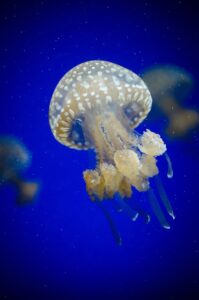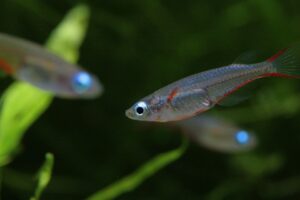
Lighting plays a crucial role in creating a healthy and balanced environment for fish and aquatic plants. Just as sunlight is essential for terrestrial ecosystems, optimal aquarium lighting is vital for the wellbeing of the inhabitants of an aquatic environment. This article explores the various aspects of aquarium lighting, including its effects on fish health, types of lighting, and how to choose the best lighting to enhance the health and vitality of your aquatic pets.
The Importance of Aquarium Lighting
Aquarium lighting serves multiple purposes beyond just illuminating the tank. It is essential for the biological processes of both fish and plants, aids in the vibrant display of colors, and influences the behavior and breeding patterns of aquatic life.
Biological Processes
Light is fundamental for photosynthesis, a process critical for live plants and, indirectly, for the fish. Plants use light to convert carbon dioxide into oxygen, which is essential for fish respiration. Furthermore, light cycles mimic natural day and night patterns, helping to regulate the biological clock of fish, promoting natural behaviors, and reducing stress.
Color Enhancement
Optimal lighting enhances the natural colors of fish, making them more vibrant and appealing. Specific wavelengths of light can bring out the best hues in different species, contributing to a visually stunning aquarium.
Behavioral Influence
Fish are sensitive to changes in light and can alter their behavior and activity levels based on the lighting conditions. Proper lighting can encourage natural behaviors such as foraging, mating, and territorial displays, which are vital for their mental and physical health.
Types of Aquarium Lighting
The choice of lighting can significantly impact the health and aesthetic of your aquarium. There are several types of lighting systems available, each with its benefits and ideal applications.
Fluorescent Lighting
Fluorescent lighting is a popular choice for many aquarists due to its energy efficiency and ability to cover a wide range of light spectrums. It is available in different Kelvin ratings, allowing customization of the light spectrum to suit specific aquatic environments. T5 and T8 are common types, with T5 providing more intense light, suitable for planted tanks and marine setups.
LED Lighting
LED lighting has gained popularity due to its longevity, energy efficiency, and customizable spectrum. LEDs are highly versatile, allowing aquarists to adjust the intensity and color, mimicking natural sunlight conditions. They produce less heat, reducing the risk of temperature fluctuations in the tank.
Metal Halide Lighting
Metal halide lights are known for their intensity and ability to penetrate deep into larger tanks. They are particularly favored in marine aquariums and setups with demanding plant species. However, they generate significant heat and require additional cooling systems.
Incandescent Lighting
Although less commonly used due to their inefficiency and heat production, incandescent bulbs can be suitable for small tanks or specific reptile and amphibian environments. They are not ideal for most fish tanks due to their limited spectrum and high energy consumption.
Choosing the Right Lighting for Your Aquarium
Selecting the appropriate lighting for your aquarium involves considering several factors, including the type of tank, the species of fish and plants, and the aesthetic goals you wish to achieve.
Consider the Inhabitants
Different species of fish and plants have varying lighting needs. For example, high-light plants such as certain species of Anubias require more intense lighting compared to low-light plants like Java Ferns. Similarly, some fish species thrive in bright environments, while others prefer dimly lit settings.
Assess the Tank Size
The size and depth of the aquarium play a crucial role in determining the right lighting system. Larger and deeper tanks may require more powerful lighting to ensure adequate penetration, whereas smaller tanks can suffice with less intense lighting.
Balance Aesthetics and Health
While aesthetics are important, the health of the tank’s inhabitants should always be the priority. Choose lighting that not only showcases the beauty of the aquarium but also supports the biological needs of the fish and plants.
Light Intensity and Duration
Understanding the appropriate intensity and duration of lighting is essential for maintaining a healthy aquarium environment.
Light Intensity
The intensity of light needed depends on the type of plants and fish in the tank. High-intensity lighting can promote the growth of plants and enhance the colors of fish. However, excessive light can lead to algae overgrowth, which can be detrimental to the tank’s ecosystem.
Light Duration
Aquariums typically require a light cycle of 8 to 12 hours a day to mimic natural daylight conditions. Timers can be used to automate the light cycle, ensuring consistency and reducing stress on the aquatic life. It’s essential to avoid prolonged periods of light exposure, as this can disrupt the natural rhythms of the fish and plants.
Preventing Algae Growth
While lighting is crucial for plant growth, it can also contribute to unwanted algae proliferation. Balancing light intensity and duration, along with regular maintenance, can help manage algae growth.
Monitor Nutrient Levels
Excess nutrients in the water can fuel algae growth. Regularly test and maintain appropriate nutrient levels, and consider using algae-inhibiting additives if necessary.
Regular Maintenance
Regularly clean the tank, trim plants, and remove debris to prevent algae from taking hold. Ensure the lighting system is clean and functioning optimally to provide a stable environment for the fish and plants.
Conclusion
Optimal aquarium lighting is a critical component of a thriving aquatic environment, enhancing fish health, supporting plant growth, and showcasing the beauty of the tank. By understanding the specific needs of your aquarium’s inhabitants and selecting the appropriate lighting system, you can create a balanced and healthy ecosystem that promotes the wellbeing of your aquatic pets. Remember to consider the type of lighting, adjust the intensity and duration, and perform regular maintenance to prevent algae growth and ensure a vibrant, healthy aquarium.
#ChatGPT assisted in the creation of this article.








